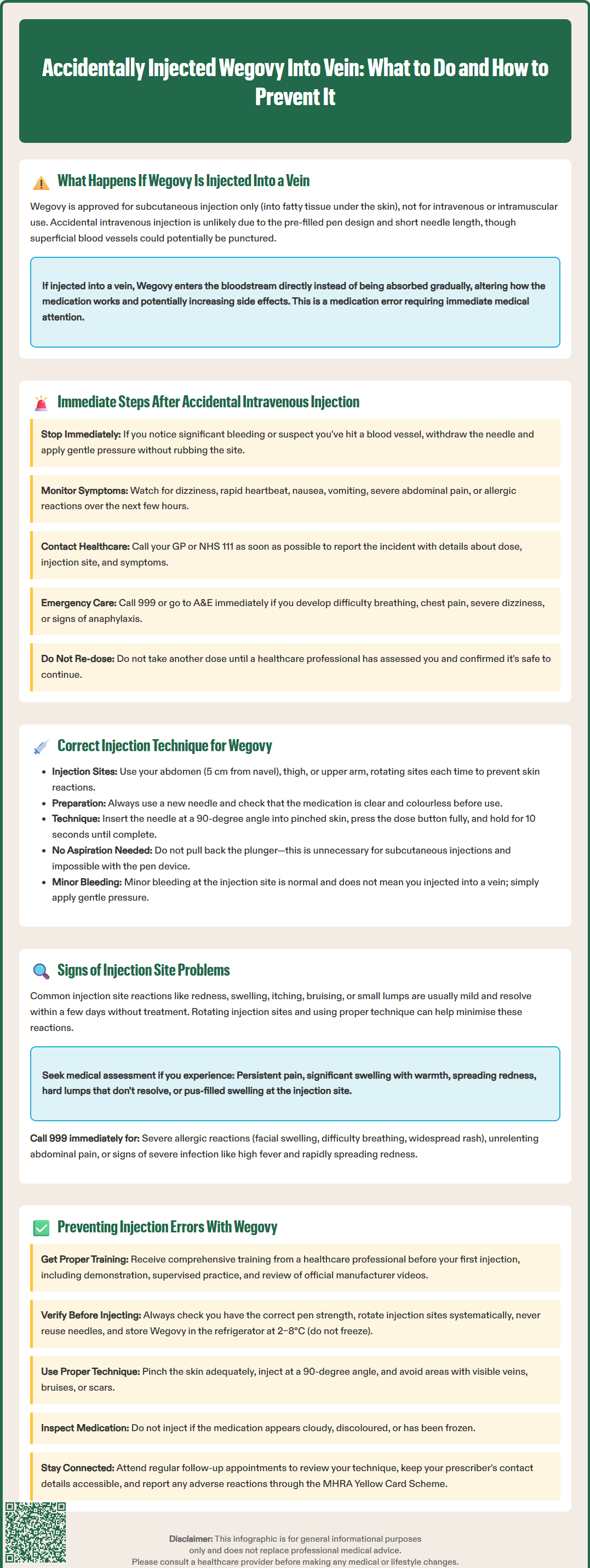
Wegovy (semaglutide) is a GLP-1 receptor agonist licensed for weight management and must be administered subcutaneously into fatty tissue beneath the skin. Accidentally injecting Wegovy into a vein is highly unlikely due to the pen device design and short needle length, but if it occurs, the medication would enter the bloodstream directly rather than being absorbed gradually. This alters the intended pharmacokinetics and may increase the risk of adverse effects. Understanding proper injection technique, recognising signs of injection errors, and knowing when to seek medical advice are essential for safe self-administration. This article provides evidence-based guidance aligned with MHRA licensing and NHS clinical practice.
Quick Answer: Accidental intravenous injection of Wegovy is unlikely but would cause direct bloodstream entry rather than gradual subcutaneous absorption, potentially increasing adverse effect risk and requiring prompt medical assessment.
Wegovy (semaglutide) is a glucagon-like peptide-1 (GLP-1) receptor agonist licensed by the MHRA for weight management in adults with obesity or overweight with weight-related comorbidities. It is specifically formulated and approved for subcutaneous injection only – meaning it should be administered into the fatty tissue layer beneath the skin. According to the Summary of Product Characteristics (SmPC), Wegovy must not be administered intravenously or intramuscularly.
Accidental intravenous injection of Wegovy is unlikely due to the design of the pre-filled pen device and the short needle length. The subcutaneous needles are designed for administration into fatty tissue, though superficial blood vessels could potentially be punctured. The injection technique recommended by the manufacturer aims to minimise this risk.
If Wegovy were to be inadvertently injected into a vein, the medication would enter the bloodstream directly rather than being absorbed gradually from subcutaneous tissue. This would alter the intended pharmacokinetics of the medication and could potentially increase the risk of adverse effects.
Any accidental intravenous administration should be treated as a medication error. If you believe Wegovy has been injected into a vein (for example, if you experienced unusual immediate symptoms or significant bleeding at the injection site), it is important to seek medical advice promptly. Contact your GP, NHS 111, or attend an urgent treatment centre for assessment. Do not attempt to administer another dose until you have received professional guidance.

If you suspect that Wegovy has been accidentally injected into a vein, remain calm and take the following steps:
Immediate actions:
Stop the injection if you notice significant bleeding at the injection site or suspect you have hit a blood vessel.
Withdraw the needle carefully and apply gentle pressure to the injection site with a clean cotton wool ball or gauze for a few minutes to prevent bruising or bleeding.
Do not rub the injection site, as this may increase local irritation or bruising.
Monitor yourself for any unusual symptoms over the next few hours, including dizziness, rapid heartbeat, nausea, vomiting, severe abdominal pain, or allergic reactions (rash, swelling, difficulty breathing).
Seeking medical advice:
Contact your GP surgery or NHS 111 as soon as possible to report the incident. Provide details including:
The dose administered
The injection site and technique used
Any immediate symptoms experienced
Keep the pen and packaging to provide batch/lot details to healthcare professionals
If you develop severe symptoms such as difficulty breathing, chest pain, severe dizziness, or signs of anaphylaxis, call 999 or attend your nearest A&E department immediately.
Do not self-administer another dose of Wegovy until you have been assessed by a healthcare professional. They will advise whether it is safe to continue with your regular dosing schedule or if any monitoring is required.

Mounjaro® is the most innovative GLP-1 medication proven to dramatically curb appetite, hunger, and cravings to help professional men achieve substantial weight loss.
Start Here
Wegovy® is a weekly injectable GLP-1 medication with proven effectiveness in reducing appetite, hunger, and cravings to help busy professionals lose significant weight.
Start HereProper injection technique is essential to ensure Wegovy is delivered subcutaneously and to minimise the risk of complications. The medication is supplied in a pre-filled, single-dose pen designed for ease of use and safety.
Approved injection sites:
Wegovy should be injected into one of three areas:
Abdomen (at least 5 cm away from the navel)
Thigh (front or outer aspect)
Upper arm (outer aspect, may require assistance)
Rotate injection sites with each dose to reduce the risk of injection site reactions.
Step-by-step technique:
Wash your hands thoroughly with soap and water.
Inspect the pen – check the medication is clear and colourless. Do not use if cloudy, discoloured, or containing particles.
Attach a new needle to the pen for each injection (needles are single-use only).
Clean the injection site with an alcohol wipe and allow to dry.
Pinch the skin gently to create a fold of subcutaneous tissue.
Insert the needle at a 90-degree angle (or 45 degrees if very lean) into the pinched skin.
Press the dose button fully and hold for 10 seconds or until the indicator shows the dose is complete, as specified in the Patient Information Leaflet.
Withdraw the needle and dispose of it safely in a sharps container.
Important notes:
Do not aspirate (pull back on the plunger) before injecting – this is not necessary for subcutaneous injections and is not possible with the pen device.
If you see blood at the injection site after withdrawing the needle, apply gentle pressure. This does not necessarily indicate intravenous injection – small blood vessels in the skin may occasionally be nicked.
Your GP practice or diabetes specialist nurse can provide hands-on training if you are uncertain about technique.
Most people tolerate Wegovy injections well, but injection site reactions can occur. It is important to distinguish between common, self-limiting reactions and signs that require medical attention.
Common injection site reactions (usually mild and self-resolving):
Redness, swelling, or itching at the injection site
Mild bruising or tenderness
Small lump under the skin (may persist for a few days)
These reactions typically resolve within a few days without treatment. Rotating injection sites and ensuring proper technique can help minimise them.
Signs requiring medical assessment:
Contact your GP or healthcare provider if you experience:
Persistent or worsening pain at the injection site lasting more than a few days
Significant swelling, warmth, or spreading redness – these may indicate infection (cellulitis)
Hard lumps or skin changes that do not resolve
Abscess formation (pus-filled swelling)
Allergic reactions – widespread rash, hives, facial swelling, or difficulty breathing (call 999 if severe)
Systemic symptoms to monitor:
While not directly related to injection site technique, be aware of Wegovy's common adverse effects:
Gastrointestinal symptoms (nausea, vomiting, diarrhoea, constipation, abdominal pain)
Signs of pancreatitis (severe, persistent abdominal pain radiating to the back)
Symptoms of gallbladder problems (right upper abdominal pain, jaundice)
Hypoglycaemia symptoms if taking other diabetes medications
Seek medical advice if severe or persistent vomiting/diarrhoea leads to dehydration
People with diabetes should report visual changes promptly
When to seek urgent help:
Call 999 or attend A&E if you develop:
Severe allergic reaction (anaphylaxis)
Severe, unrelenting abdominal pain
Signs of severe infection (high fever, rigors, rapidly spreading redness)
Preventing injection errors requires a combination of proper training, careful technique, and awareness of potential pitfalls. Following these evidence-based strategies can significantly reduce the risk of complications.
Education and training:
Ensure you receive comprehensive training from your prescriber, practice nurse, or pharmacist before your first injection.
Request a demonstration and supervised practice session.
Review the patient information leaflet and manufacturer's instructions thoroughly.
Watch the official training videos available from Novo Nordisk (Wegovy's manufacturer) or NHS resources.
Practical prevention strategies:
Use proper lighting and a clean, flat surface when preparing your injection.
Check you have the correct pen strength and weekly dosing schedule; verify the label/colour strength before injecting.
Rotate injection sites systematically – keep a log if helpful.
Never reuse needles – this increases infection risk and can damage the pen mechanism.
Store Wegovy correctly – in the refrigerator (2–8°C); if needed, each pen may be kept below 30°C for up to 6 weeks before use. Do not freeze; keep the cap on; do not use if frozen.
Inspect the medication before each use – do not inject if it appears cloudy or discoloured.
Avoiding intravenous injection specifically:
Use the correct needle length (provided with the pen) – these are designed for subcutaneous delivery.
Pinch the skin adequately to lift subcutaneous tissue away from underlying muscle.
Inject at the recommended angle (90 degrees for most people).
Do not inject into areas with visible veins, bruises, scars, or skin abnormalities.
Support and follow-up:
Attend regular follow-up appointments to review technique and discuss any concerns.
Join patient support groups or educational programmes if available through your healthcare provider.
Keep contact details for your prescriber or specialist nurse readily available.
Report any adverse reactions via the MHRA Yellow Card Scheme (yellowcard.mhra.gov.uk) to contribute to medication safety surveillance.
By following the manufacturer instructions and NHS training materials, you can safely self-administer Wegovy and maximise its therapeutic benefits whilst minimising risks. If you ever feel uncertain about any aspect of your injection technique, do not hesitate to contact your healthcare team for clarification and support.
Stop the injection immediately, withdraw the needle, and apply gentle pressure to the site with clean gauze. Monitor yourself for unusual symptoms such as dizziness, rapid heartbeat, or severe nausea, and contact your GP or NHS 111 promptly for assessment. Do not administer another dose until you receive professional guidance.
Use proper subcutaneous injection technique by pinching the skin to lift fatty tissue, injecting at a 90-degree angle into approved sites (abdomen, thigh, or upper arm), and avoiding areas with visible veins or bruising. Rotate injection sites with each dose and ensure you receive comprehensive training from your healthcare provider before starting treatment.
Call 999 or attend A&E immediately if you develop severe symptoms including difficulty breathing, chest pain, severe or persistent abdominal pain, signs of anaphylaxis (facial swelling, widespread rash), or signs of severe infection such as high fever with rapidly spreading redness at the injection site.
All medical content on this blog is created based on reputable, evidence-based sources and reviewed regularly for accuracy and relevance. While we strive to keep content up to date with the latest research and clinical guidelines, it is intended for general informational purposes only.
DisclaimerThis content is not a substitute for professional medical advice, diagnosis, or treatment. Always consult a qualified healthcare professional with any medical questions or concerns. Use of the information is at your own risk, and we are not responsible for any consequences resulting from its use.